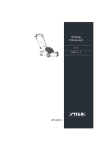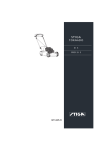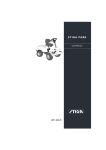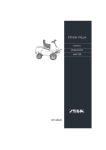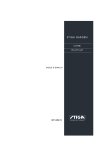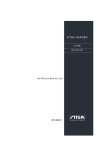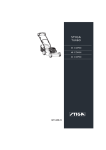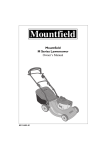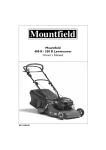Download Stiga 46 S EURO Lawn Mower User Manual
Transcript
STIGA MULTICLIP 46 S 46 SE 46 S EURO 8211-0203-12 S SVENSKA 1 2 1 2 3 4 3 4 2. 3. 4. Multiclip 46 SE FULL 1. FULL ADD ADD FULL ADD 0,15 l. 5. Briggs & Stratton LS 40/45 6. Briggs & Stratton ES 45 G STOP I N FULL I ADD 7. Honda EURO 8. Multiclip 46 S G S SVENSKA G STOP I N 3x 9. Multiclip 46 SE 10. Briggs & Stratton LS 45 3x 11. Briggs & Stratton ES 45 12. Honda S S FRONT 13. 15. S REAR 14. 16. S 17. Briggs & Stratton LS 45 SVENSKA 18. Briggs & Stratton ES 45 Briggs & Stratton : 0,75 mm 0,75 mm Honda: 0,7-0,8 mm 19. Honda 20. 21. 22. 40 Nm GB ENGLISH SYMBOLS The following symbols appear on the machine. They are there to remind you of the care and attention required in use. This is what the symbols mean: Warning! Read the Instruction Book and Safety Manual before using the machine. Warning! Keep onlookers away. Beware of objects being flung out. Warning! Do not insert your hands or feet under the deck when the machine is in operation. Warning! Before starting any repair work, remove the spark plug cable from the spark plug. Warning! Always tilt the lawnmower backwards when cleaning the underside. Petrol and oil can run out if the lawnmower is tilted in the other direction. IMPORTANT Certain models do not have throttle control. The engine’s speed is set for optimal function and minimal exhaust emissions. ASSEMBLY 3. Parking position. 4. Delivery and storage position. The handle takes up less space if the knobs are released and the handle folded up. NOTE! Check that the wires are not caught or broken when the handle is unfolded or folded. CONTROLS Install the wires and electric cable (Multiclip 46 SE) in the cable holders E (fig. 3). Secure the starter handle in lug F on the right hand side of the handle. BATTERY (Multiclip 46 SE) The electrolyte in the battery is toxic and corrosive. It can cause serious corrosion damage etc. Avoid all contact with skin, eyes and clothing. Before starting for the first time the battery should be charged for 24 hours, see further information under the heading MAINTENANCE, BATTERY. USING THE MOWER BEFORE STARTING FILL THE CRANKCASE WITH OIL The lawnmower is delivered without any oil in the engine crankcase. The crankcase must be filled with oil before the engine is started for the first time. 1. Remove the oil dipstick (fig. 5, 6, 7). 2. Fill the engine’s crankcase with 0.55 litres of good quality oil (service class SE, SF or SG). Use SAE 30 or SAE 10W-30 oil. 3. Slowly fill to ‘FULL/MAX’. Do not overfill. HANDLE Fold up the lower part of the handle. Then attach the upper part of the handle. This is attached with screws, washers and locking wheels (fig. 1). The handle has four different positions. Release the catch with your foot and set the handle in desired position (fig. 2). 1. For normal mowing. 2. For mowing under trees, bushes, etc. CHECK THE OIL LEVEL Check before using the machine that the oil level is between ‘FULL/MAX’ and ‘ADD/MIN’ on the dipstick. The mower should stand level. Briggs Stratton: Remove and wipe off the dipstick (fig. 5, 6). Slide it down completely and tighten it. Unscrew and pull it up again. Read off the oil level. If the oil level is low, fill with oil up to the ‘FULL/MAX’ mark. GB ENGLISH Honda: Remove and wipe off the dipstick (fig. 7). Insert the dipstick fully, but do not screw it into the thread. Pull it up again. Read off the oil level. If the oil level is low, fill with oil up to the ‘FULL/MAX’ mark. FILL UP THE PETROL TANK Never remove the filler cap or fill with petrol while the engine is running or still warm. 5. Press the Start/Stop loopG towards the handle. NOTE! The Start/Stop loopG must be kept pressed in to prevent the engine stopping (fig. 8, 9). 6. For ease of starting, press down the handle so that the front wheels lift slightly from the ground. Do not start in thick grass. Multiclip 46 SGrasp the starter handle and start the engine by pulling briskly on the starter cord. Never completely fill the petrol tank. Allow a little room for the petrol to expand if necessary. Some engines have an extra safety cover under the regular fuel cap. This must not be reinstalled. Multiclip 46 SE: Start the engine by turning the ignition key clockwise. Release the key as soon as the engine starts. Always make short attempts at starting in order to prevent the battery running down. Preferably use an environmentally friendly petrol, i.e. alkylate petrol. This type of petrol has a composition that is less harmful to people and nature. It has e.g. no lead additives, no oxygenators (alcohols and ethers), no alkenes and no benzene. 7. For the best mowing results, the engine should always be driven at full throttle. NOTE! If you change to environmentally friendly petrol in an engine previously run on ordinary lead-free petrol (95), the petrol manufacturer’s recommendations must be followed carefully. Ordinary lead-free 95 octane petrol can also be used. You must never use 2-stroke petrol mixed with oil. NOTE! Bear in mind that ordinary leadfree petrol is a perishable; do not purchase more petrol than can be used within thirty days. STARTING THE ENGINE (Briggs & Stratton) 1. Place the lawnmower on flat, firm ground. Do not start in long grass. 2. Make sure the spark plug cable is connected to the spark plug. 3. If the lawnmower is equipped with throttle control, set the throttle control N to full throttle (fig. 8, 9). 4. When starting a cold engine: Press down the primer fully 6 times (fig. 10, 11). When starting a warm engine the primer does not need to be used. If the engine stops due to a lack of fuel, refill and press down the primer 3 times. Keep hands and feet away from the rotating blade. Never put your hand or foot under the blade casing or in the grass ejector while the engine is running. STARTING THE ENGINE (Honda) 1. Place the lawnmower on flat, firm ground. Do not start in long grass. 2. Make sure the spark plug cable is connected to the spark plug. 3. Open the fuel tap (fig. 12). 4. Move the throttle control N to the choke position . NOTE! It is not necessary to use the choke position when the engine is warm (fig. 8). 5. Press the Start/Stop loopG towards the handle. NOTE! The Start/Stop loopG must be kept pressed in to prevent the engine stopping (fig. 8). 6. Grasp the starter handle and start the engine by pulling briskly on the starter cord. 7. When the engine starts, move the throttle control backwards until max. revs are obtained. NOTE! The engine should always be run at maximum revs to avoid abnormal machine vibrations. Keep hands and feet away from the rotating blade. Never put your hand or foot under the blade casing while the engine is running. GB ENGLISH ENGAGING/DISENGAGING THE DRIVE Engaging the drive is facilitated by pressing down the handlebar so that the driving wheels are raised slightly from the ground. Engage the drive by pressing the clutch loop I towards the handle. Disengage the drive by releasing the clutch loop I (fig. 8, 9). By allowing the driving wheels to be raised slightly from the ground, turning, reversing, moving round trees, etc., can be performed without having to disengage the drive system. STOPPING THE ENGINE The engine may be very warm immediately after it is shut off. Do not touch the silencer, cylinder or cooling fins. This can cause burn injuries. 1. Release Start/Stop loop G to stop the engine (fig. 8, 9). This loop must not be disengaged (e.g. by setting it in the depressed position against the handle), as it will not be possible to stop the engine. Honda: Close the fuel tap. 2. If the lawnmower is left unattended, remove the spark plug cable from the spark plug. Multiclip 46 SE: Also remove the starter key. If the start/stop loop ceases to work, stop the engine by removing the spark plug cable from the spark plug. Immediately take the lawnmower to an authorised workshop for repair. DRIVING TIPS Before mowing the lawn, take care to remove any stones, toys and other hard objects. A machine with the MULTICLIP system cuts the grass, chops it finely and then blows it down into the lawn. The grass clippings need not be collected. The following rules should be observed to give the best MULTICLIP effect: 1. Use a high engine speed (full throttle). 2. Do not cut the grass too short. Not more than 1/ 3rd of the length should be cut off. 3. Ensure that the area under the mower casing is always kept clean. 4. Always use a well-sharpened blade. 5. Avoid mowing when the grass is wet. The grass sticks more easily to the underside of the casing, giving poorer mowing results. CUTTING HEIGHT Shut off the engine before adjusting the cutting height. Do not set the cutting height so low that the blades come into contact with uneven ground. The lawnmower has rapid setting with 4 cutting heights on the front wheels. It is possible to vary the rear cutting height by moving the wheel axle through four positions (fig. 13). Make sure that you have the same cutting height set on all wheels. MAINTENANCE No servicing is to be carried out on the engine or mower unit without first switching off the engine and removing the spark plug cable from the spark plug. Multiclip 46 SE: No servicing may be carried out on the engine or mower unit without disconnecting the battery terminal from the terminal on the motor (fig. 4). Stop the engine and remove the spark plug cable if the mower is to be lifted, e.g. during transportation. If the machine needs to be tilted, the fuel tank must be emptied and the engine’s spark plug kept upright. CLEANING After use, the mower should be cleaned. This is particularly important on the underside of the mower casing. Rinse clean with the garden hose. The mower will then last longer and work better. NOTE! High-pressure washers should not be used. If grass has dried on to the mower casing, it can be scraped clean. If necessary, touch up the underside with paint to prevent rust damage. GB ENGLISH Clean the silencer and the surrounding area regularly to remove grass, dirt and flammable waste products. Wash the filter every three months or after every 25 hours of use, whichever occurs first. More frequently if the engine is working on dusty ground. NOTE! Clean under the transmission casing once or twice a year. Set the lowest cutting height. Undo the screws and remove the transmission casing (fig. 14). Clean with brush or compressed air. Briggs & Stratton ES 45: Undo the screw and fold down the cover of the air cleaner. Carefully remove the filter cartridge (fig. 18). Knock it against a flat surface. Replace the filter cartridge with a new one if it is still dirty. Once every season, the drive wheels should be cleaned internally. Remove the wheel cap, screw, washer and wheel. Clean the gear wheel and the wheel’s gear rim of grass and dirt using a brush or compressed air (fig. 15). Replace the wheel. COOLING SYSTEM Before each use, the engine’s cooling system must be cleaned. Clean the cylinder’s cooling flanges and air intake of grass remains, dirt, etc. LUBRICATION Set the lowest cutting height. Remove the screws and dismantle the transmission casing. Lubricate the drive shaft at the glide bearings with oil/oil spray at least once per season (fig. 16). OIL CHANGE Change the oil when the engine is warm and the fuel tank is empty. In order to prevent burns, take care while draining as the oil is hot. Change the oil the first time after 5 hours of operation, and subsequently every 50 hours of operation or once a season. Remove the dipstick, tilt the mower and let the oil run out into a container. Be careful not to let any oil run on to the grass. Fill with new oil: Use SAE 30 or SAE 10W-30 oil. The crankcase holds approx. 0.55 litres. Fill until the oil reaches the “FULL/MAX” mark on the dipstick. Do not overfill. AIR FILTER A dirty and blocked air filter reduces the engine output and increases engine wear. Briggs & Stratton LS 40/45: Carefully remove the air cleaner so that no dirt falls down into the carburettor (fig. 17). Remove the foam filter and wash it in liquid detergent and water. Dry the filter. Pour a little oil on the filter and squeeze it in. Reassemble the air cleaner. Clean the filter every three months or after every 25 hours of use, whichever occurs first. More often if the lawnmower is used on dusty ground. Honda: Remove the cover and take out the filter (fig. 19). Carefully check the filter for holes or other damage. A broken or damaged filter must be replaced. To remove dirt, carefully knock the filter several times against a hard surface or use compressed air from the back of the filter to blow-clean. Do not try to brush the filter clean as this forces dirt down into the fibres. A very dirty filter should be replaced. Clean the air filter after every 25 hours of operation or once a season. More frequently if the engine is working on dusty ground. SPARK PLUG Never remove the spark plug or spark plug cable when checking to see if there is a spark. Use an approved test instrument. Clean the spark plug regularly (every 100 hours of operation). Use a wire brush for cleaning. Set the correct spark gap (fig. 20). Change the spark plug if the electrodes are excessively burnt or if the plug is damaged. The engine manufacturers’ recommendations are as follows: Briggs & Stratton: Champion J19LM (RJ19LM), Spark gap 0.7-0.8 mm. Honda: BPR6ES (NGK), Spark gap 0.7-0.8 mm. BATTERY (Multiclip 46 SE) The electrolyte in the battery is toxic and corrosive. It can cause serious corrosion damage etc. Avoid all contact with skin, eyes and clothing. In normal use during the season, the battery is charged by the engine. If the engine cannot be started with the ignition key, it may be because the GB ENGLISH battery is ‘dead’. Connect the battery charger to the terminal on the battery and charge for 24 hours (fig. 4). On completion of charging, connect the battery terminal to the terminal on the engine. NOTE! The battery charger must not be connected directly to the engine terminal. It is not possible to start the engine with the charger as the power source and the charger could be damaged. WINTER STORAGE Store the lawnmower for the winter with the battery well-charged in a dry and cool place (between 0°C and +15°C). The battery should be maintenance-charged at least once during the winter storage period. Before the start of the season, the battery should be charged once again for 24 hours. ADJUSTING CLUTCH CABLE If the drive does not engage when the clutch loop is pressed against the handle, or if the lawnmower feels cumbersome or slow, this may be because the clutch in the transmission is slipping. To rectify this situation adjust the clutch cable. Adjust as follows: 1. When the clutch loop is released, it should be possible to push the mower without any resistance. If this is not the case, screw in the nipple T until the mower can be pushed (fig. 21). 2. When the clutch loop is pressed in approx. 2 cm (position 1), there should be some resistance when pushing the lawnmower. With the clutch loop fully pressed in (position 2) it should not be possible to push the mower. Unscrew the nipple T until this position is achieved. CHANGING BLADES Use protective gloves when changing blade to avoid cutting yourself. Blunt and damaged blades tear up the grass and make the lawn unsightly after mowing. New wellsharpened blades cut off the grass. This gives a green and fresh appearance after mowing. Always check the blade after an impact. First disconnect the spark plug cable. If the blade system has been damaged, defective parts should be replaced. Always use genuine spare parts. To replace the blade, slacken the screw. Fit the new blade so that the stamped STIGA logo is facing the blade holder (not facing the grass). Reinstall the washer and screw. Tighten the screw properly. Tightening torque 40 Nm (fig. 22). When replacing the blade, the blade screw should also be replaced. The guarantee does not cover damage to the blade, blade holder or engine caused by running into obstacles. When replacing the blade, blade holder and blade screw, always use genuine spare parts. Non-genuine spare parts can entail a risk of injury or damage, even if they fit the machine. SHARPENING THE BLADES Sharpening of the blades must be performed by wet grinding, using a whetstone or a grindstone. For safety reasons, the blades should not be sharpened on an emery wheel. Too high temperature could cause the blade to become brittle. Once the blade has been sharpened, it must then be balanced to avoid vibration damage. STORAGE WINTER STORAGE Empty the fuel tank. Start the engine and let it run until it stops. The same petrol must not remain in the tank for more than one month. Tip up the mower and unscrew the spark plug. Pour a tablespoon of engine oil into the spark plug hole. Pull out the starter handle slowly so that the oil is distributed in the cylinder. Screw in the spark plug. Thoroughly clean the mower and store it indoors in a dry place. SERVICING Genuine spare parts are supplied by service workshops and by many dealers. A list of these can be found on STIGA’s Internet website at: www.stiga.com. EG-försäkran om överensstämmelse EY-vaatimustenmukaisuusvakuutus EU-overensstemmelseserklæring EU-forsikring om overensstemmelse EG-Konformitätsbescheinigung Gräsklippare med bensinmotor Bensiinimoottorikäyttöinen ruohonleikkuri Plæneklipper med benzinmotor Gressklipper med bensinmotor Rasenmäher mit Benzinmotor Lawnmowers with petrol engines Tondeuses à moteur à explosion Grasmaaiers met benzinemotor Tosaerba con motori a benzina Cortacéspedes con motor de gasolina Máquinas de cortar relva com motores a gasolina Kosiarki do trawy z silnikiem benzynowym Газонокосилки с бензиновым двигателем Sekačky trávy s benzinovým motorem Benzinmotoros fűnyíró Kosilnice z bencinskimi motorji 1.Kategori Luokka Kategori Kategori Kategorie Category Catégorie Categorie Categoria Categoría Categoria Kategoria Категория Kategorie Kategória Kategorija 2.Typ Tyyppi Type Type Typ Type EC conformity declaration Déclaration de conformité CE EU-gelijkvormigheidsverklaring Dichiarazione di conformità CE Declaración de conformidad CE Type Type Tipo Tipo Tipo Typ Тип Typ Típus Tip S462 3.Art.nr. Tuotenumero Art.nr. Art.nr. Art.-Nr. Item no N° d'article Itemnr. Articolo n. Nº de referencia Item nº Pozycja nr Арт. изд. Císlo položky Tételszám Izdelek, št. 1. 11-3603 2. 11-3681 3. 11-3698 4.Tillverkare Valmistaja Producent Produsent Hersteller Manufacturer Fabricant Fabrikant Produttore Fabricante Fabricante Producent Изготовитель Výrobce Gyártó Proizvajalec GGP Sweden AB P.O. Box 1006 SE-573 28 Tranås Sweden Торговая марка Značka Gyártmány Znamka Marque Fabricage Marca Marca Marca Marka 8.Fabrikat Valmiste Fabrikat Fabrikat Fabrikat Make 9.Klippbredd Leikkuuleveys Klippebredde Klippebredde Schnittbreite Cutting width Largeur de coupe Snijwijdte Larghezza di taglio 46 cm Ancho de corte Largura de corte Szerokość koszenia Рабочий захват Šířka sekání Vágási szélesség Širina košnje 10.Serienr Valmistenumero Serienr. Serienr. Seriennummer Serial number Numéro de série Serienummer Numero di serie Número de serie Número de série Numer seryjny Заводской номер Číslo série Sorozatszám Serijska številka STIGA Se dekal på chassit Katso tarra rungossa Se mærkat på chassis Se etikett på chassiset Siehe Schild am Chassis See label on chassis Voir la plaque sur le châssis Zie label op chassis Vedi etichetta sul telaio Véase la etiqueta en el chasis Ver etiqueta no chassis Patrz etykieta na podwoziu См. табличку на шасси Viz štítek na podvozku Lásd az alvázon lévő adattáblát! Glej nalepko na šasiji 11.Motor / Moottori / Motor / Motor / Motor / Engine / Moteur / Motor / Motore / Motor / Motor / Silnik / Двигатель / Motor / Motor / Motor Vibração Wibracje Вибрация Vibrace Vibráció Tresljaji 1. 9.0 m/s2 (Σ) 2. 7.0 m/s2 (Σ) 3. 7.0 m/s2 (Σ) Fabrikat Valmiste Fabrikat Fabrikat Fabrikat Make Marque Fabricage Marca Marca Marca Marka Марка Značka Gyártmány Znamka 1. Honda 2-3. Briggs & Stratton Modell Malli Model Modell Modell Model Modèle Model Modello Modelo Modelo Model Модель Model Modell Model 1. 2. 3. STOP 5.Vibration Tärinä Vibration Vibrasjon Vibration Vibration Vibration Vibratie Vibrazioni Vibración Izjava ES o skladnosti Declaração de conformidade da CE Deklaracja zgodności EC Декларация EC о соответствии Deklarace shody s EU EK megfelelőségi nyilatkozat 6A.Garanterad ljudeffektnivå Taattu äänitehotaso Garanteret lydeffektniveau Garantert lydeffektnivå Garantierter Geräuschpegel Guaranteed sound power level Niveau de puissance acoustique garanti Gegarandeerd geluidsniveau Livello di potenza sonora garantito Nivel de potencia de sonido garantizado Nível de ruído garantido Nieprzekraczalny poziom hałasu Гарантированный предельный уровень шума Zaručená úroveň hluku Garantált hangteljesítményszint Zajamčena raven zvočne jakosti 1: 94 dB(A) 2-3: 95 dB(A) 12.Rotationshastighet Pyörimisnopeus Rotationshastighed Rotasjonshastighet Umdrehungsgeschwindigkeit Rotation speed Vitesse de rotation Rotatiesnelheid Velocità di rotazione Régimen Velocidade de rotação Prędkość obrotów Частота вращения Rychlost otáčení Rotációs sebesség Hitrost vrtenja GCV 135 10D902 127707 1. 2900 rpm 2-3. 3000 rpm (LWA) 6B.Uppmätt ljudeffektnivå Mitattu äänitehotaso Målt lydeffektniveau Målt lydeffektnivå Gemessener geräuschpegel Measured sound power level Niveau de puissance acoustique mesuré Gemeten geluidsniveau Livello di potenza sonora misurato Nivel de potencia de sonido medido Nível de potência sonora medido Nieprzekraczalny poziom hałasu Замеренный уровень шума Naměřená úroveň hluku Mért hangteljesítményszint Izmerjena raven zvočne jakosti 1: 2-3: 91 dB(A) 92 dB(A) 7.Anmält organ Ilmoitettu laitos Bemyndiget organ Underrettet organ Anmeldeorganisation Notified body Organisme notifié Keuringsinstantie Organismo notificato Organismo notificado Organismo notificado Urząd zatwierdzający Уполномоченная организация Oprávnený orgán Az értesítés címzettje Obveščeni organ ITS Testing & Certification Ltd Notified Body representative 0359 EG-försäkran om överensstämmelse EY-vaatimustenmukaisuusvakuutus EU-overensstemmelseserklæring EU-forsikring om overensstemmelse EG-Konformitätsbescheinigung EC conformity declaration Déclaration de conformité CE EU-gelijkvormigheidsverklaring Dichiarazione di conformità Declaración de conformidad CE Declaração de conformidade da CE Deklaracja zgodności EC Декларация EC о соответствии Deklarace shody s EU EK megfelelőségi nyilatkozat Denna produkt är i överensstämmelse med - direktiv 89/336/EEG om elektromagnetisk kompatibilitet - maskindirektiv 98/37/EEG med särskilda hänvisningar till direktivets bilaga 1 om väsentliga hälso- och säkerhetskrav i samband med tillverkning - ljuddirektiv 2000/14/EG Maskinen är utvecklad och tillverkad enligt följande standard: - EN 836, EN 292-2, EN 1033, EN ISO 3767, EN ISO 14982 Tämä tuote täyttää seuraavien direktiivien vaatimukset - sähkömagneettista yhteensopivuutta koskeva direktiivi 89/336/ETY - konedirektiivi 98/37/ETY viitaten erityisesti direktiivin liitteeseen 1, joka käsittelee olennaisia terveys- ja turvallisuusvaatimuksia valmistuksen yhteydessä - meludirektiivi 2000/14/EG Tuote on kehitetty ja valmistettu seuraavien normien mukaisesti: - EN 836, EN 292-2, EN 1033, EN ISO 3767, EN ISO 14982 Dette produkt er i overensstemmelse med - direktiv 89/336/EØF om elektromagnetisk kompatibilitet - direktiv 98/37/EØF om indbyrdes tilnærmelse af medlemsstaternes lovgivning om maskiner med særlig henvisning til direktivets bilag 1 om væsentlige sikkerheds- og sundhedskrav i forbindelse med konstruktion og fremstilling - direktiv 2000/14/EF om støjemission Produktet er udviklet og fremstillet i overensstemmelse med følgende normer: - EN 836, EN 292-2, EN 1033, EN ISO 3767, EN ISO 14982 Dette produktet er i overensstemmelse med - direktiv 89/336/EØF om elektromagnetisk kompatibilitet - maskindirektiv 98/37/EØF med særskilte henvisninger til direktivets bilag 1 om vesentlige helse- og sikkerhetskrav i forbindelse med produksjon - lyddirektiv 2000/14/EF Produktet en utviklet og produsert i overensstemmelse med følgende normer: - EN 836, EN 292-2, EN 1033, EN ISO 3767, EN ISO 14982 Dieses Produkt ist in Übereinstimmung mit - Direktive 89/336/EEG zur elektromagnetischen Kompatibilität - Maschinendirektive 98/37/EEG mit besonderem Hinweis auf Anlage 1 der Direktive über wichtige Gesundheits- und Sicherheitsanforderungen im Zusammenhang mit der Herstellung - Schallschutzdirektive 2000/14/EG Das Erzeugnis ist in Übereinstimmung mit folgenden Normen entwickelt und gefertig worden: - EN 836, EN 292-2, EN 1033, EN ISO 3767, EN ISO 14982 This product conforms to - Electromagnetic Compatibility Directive 89/336/EEC - Machinery Directive 98/37/EEC with special reference to appendix 1 of the directive regarding essential health and safety requirements in conjunction with manufacturing - Noise Emission Directive 2000/14/EC This product has been developed and manufactured in conformance with the following standards: - EN 836, EN 292-2, EN 1033, EN ISO 3767, EN ISO 14982 Izjava ES o skladnosti Este producto respeta las siguientes normas: - Directiva 89/336/CEE sobre compatibilidad electromagnética - Directiva 98/37/CEE sobre máquinas, especialmente su anexo 1 sobre los requisitos esenciales de seguridad y de salud relativos a la fabricación de las máquinas - Directiva 2000/14/CE relativa a las emisiones sonoras Referente a standards armonizados: - EN 836, EN 292-2, EN 1033, EN ISO 3767, EN ISO 14982 Este produto está em conformidade com - Directiva sobre Compatibilidade Electromagnética 89/336/CEE - Directiva relativa às Máquinas 98/37/CEE com referência especial ao apêndice 1 da directiva referente aos requisitos essenciais de saúde e segurança em conjunto com os de fabrico. - Directiva sobre Emissão de Ruído 2000/14/CE Referencias à normas harmonizadas: - EN 836, EN 292-2, EN 1033, EN ISO 3767, EN ISO 14982 Ten produkt odpowiada następującym normom: - Kompatybilność elektromagnetyczna - dyrektywa 89/336/EEC - Maszyny - dyrektywa 98/37/EEC, a szczególnie dodatkiem 1 dyrektywy, dotyczącym podstawowych wymogów w zakresie zdrowia i bezpieczeństwa w związku z produkcją. - Emisja hałasu - dyrektywa 2000/14/EC W odniesieniu do norm harmonizujących: - EN 836, EN 292-2, EN 1033, EN ISO 3767, EN ISO 14982 Tento výrobek vyhovuje - Smernici o elektromagnetické kompatibilite 89/336/EEC - Smernici o strojních zarízeních 98/37/EEC se speciálním odkazem na prílohu 1 uvedené smernice týkající se duležitých požadavku na ochranu zdraví a bezpecnost v souvislosti s výrobou - Smernici o emisích hluku 2000/14/EC Použité harmonizované normy: - EN 836, EN 292-2, EN 1033, EN ISO 3767, EN ISO 14982 Ta izdelek je v skladu z - Direktivo 89/336/EGS o elektromagnetni zdru_ljivosti - Direktivo 98/37/EGS o strojih, s posebnim sklicevanjem na njen Dodatek 1 v zvezi z osnovnimi zdravstvenimi in varnostnimi zahtevami, skupaj s proizvodnjo - Direktivo 2000/14/ES o emisijah hrupa Hivatkozás a harmonizált szabványokra: - EN 836, EN 292-2, EN 1033, EN ISO 3767, EN ISO 14982 Ce produit est conforme à - La Directive compatibilité électromagnétique 89/336/EEC - La Directive machines 98/37/EEC, avec une référence particulière à l'annexe 1 de la directive concernant les exigences essentielles en matière de santé et de sécurité dans le cadre de la fabrication - La Directive émissions de bruit 2000/14/EC Le produit en question a été mis au point et fabriqué conformément aux normes suivantes: - EN 836, EN 292-2, EN 1033, EN ISO 3767, EN ISO 14982 Dit product voldoet aan - Richtlijn voor elektromagnetische compatibiliteit 89/336/EEC - Richtlijn voor machines 98/37/EEC met speciale verwijzing naar aanhangsel 1van de richtlijn voor essentiële gezondheids-en veiligheidsvereisten i.v.m. fabricage - Richtlijn voor geluidsproductie 2000/14/EC Het product is in overeenstemming met volgende normen ontwikkeld en vervaardigd: - EN 836, EN 292-2, EN 1033, EN ISO 3767, EN ISO 14982 Questo prodotto è conforme alla - Direttiva sulla compatibilità elettromagnetica 89/336/EEC - Direttiva Macchine 98/37/EEC con particolare riferimento all'appendice 1 della direttiva riguardante i requisiti essenziali in materia di salute e sicurezza relativi alla fabbricazione - Direttiva sulle emissioni sonore 2000/14/EC Riferimento alle norme armonizzate: - EN 836, EN 292-2, EN 1033, EN ISO 3767, EN ISO 14982 Utfärdat i Tranås Annettu Tranåsissa Udfærdiget i Tranås Utstedt i Tranås Ausgefertigt in Tranås, Schweden Issued in Tranås Fait à Tranås Gepubliceerd in Tranås Rilasciata a Tranås Emitido en Tranås Publicado em Tranås Wydano w Tranås Выдано в Траносе Vydáno v Tranåsu Kibocsátva Tranåsban Izdano v Tranås Mats Antonsson 2002-12-02 Certifieringsansvarig Sertifioinnista vastaava Certificeringsansvarlig Sertifiseringsansvarlig Für die Zertifizierung verantwortlich Certification Manager Directeur de Certification Certification Manager Direttore Certificazione Responsable de certificación Director de Certificação Kierownik ds. legalizacji Начальник службы сертификации Vedoucí pro certifikaci A tanúsításért felelős igazgató Poslovodja za izdajo certifikatov NOTES .................................................................................................................................................................... .................................................................................................................................................................... .................................................................................................................................................................... .................................................................................................................................................................... .................................................................................................................................................................... .................................................................................................................................................................... .................................................................................................................................................................... .................................................................................................................................................................... .................................................................................................................................................................... .................................................................................................................................................................... .................................................................................................................................................................... .................................................................................................................................................................... .................................................................................................................................................................... .................................................................................................................................................................... .................................................................................................................................................................... .................................................................................................................................................................... .................................................................................................................................................................... .................................................................................................................................................................... .................................................................................................................................................................... .................................................................................................................................................................... .................................................................................................................................................................... .................................................................................................................................................................... .................................................................................................................................................................... .................................................................................................................................................................... .................................................................................................................................................................... .................................................................................................................................................................... .................................................................................................................................................................... .................................................................................................................................................................... .................................................................................................................................................................... .................................................................................................................................................................... .................................................................................................................................................................... .................................................................................................................................................................... .................................................................................................................................................................... .................................................................................................................................................................... .................................................................................................................................................................... .................................................................................................................................................................... M OWI NG A H E AD GGP Sweden AB · Box 1006 · SE-573 28 T RANÅ S w w w. s t i g a . c o m













